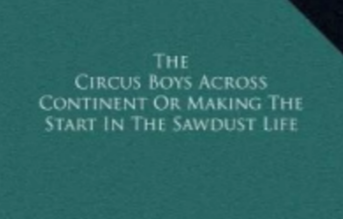CHAPTER VIII — The Circus Boys Across the Continent
byCHAPTER VIII — The Circus Boys Across the Continent begins with the full splendor of the big top unfolding before a packed crowd. A grand opening parade dazzles the audience, modeled after Roman pageantry, with lavish costumes, plumed horses, towering elephants, and synchronized performers moving to a rousing circus anthem. At the center of the spectacle is Phil Forrest, hidden beneath a bonnet and perched atop Emperor, the elephant. As the act reaches its climax, Phil is smoothly lifted by concealed wires, descending to the ring with an elegant sweep that leaves the audience in awe. The applause that follows isn’t just polite—it roars with genuine admiration. Phil’s seamless execution marks him as more than a participant; he’s becoming a standout presence in the show. His act blends physical courage with showmanship, highlighting how carefully crafted innovation can become magic under the big top.
Backstage, the energy is lighter but no less meaningful. Phil and Teddy reflect on the night’s performance, sharing jokes and dreams about future stunts they might try. Teddy imagines being shot from a cannon, while Phil wonders about mastering the flying trapeze. These conversations, though playful, reflect their genuine desire to grow and challenge themselves within the circus world. Their dialogue shows the optimism and grit that carry young performers through long tours and grueling rehearsals. Beneath the laughter lies a bond rooted in shared ambition and mutual encouragement. The circus may seem chaotic, but its performers are bound together by a shared mission—to entertain, improve, and look out for one another. For Phil and Teddy, every day brings a new opportunity to build skill and earn trust.
Phil’s attention later shifts to the center ring, where “Little Miss Dimples” makes her entrance for the bareback riding act. She performs with a fluid grace that holds the entire audience in rapt attention, leaping and balancing on a galloping horse as though born to the sawdust. Phil, watching closely, is not just impressed—he’s inspired. When Dimples finishes with a final flourish and throws him her whip with a smile, it feels like a passing of the torch, or perhaps the start of a connection built on respect. Though their interaction is brief, it hints at the possibility of mentorship or collaboration in future chapters. Dimples’ poise reminds Phil what dedication and artistry can accomplish in the ring.
The scene also offers insight into the rigorous preparation behind such acts. Every second of the performance is supported by intense training and precise timing, often overlooked by the cheering crowd. Phil notices subtle imperfections—a slightly uneven ring surface or an unsteady prop—that could have caused a serious accident. His concern reveals not just a performer’s eye but a growing sense of responsibility for the entire show’s success. While others celebrate, Phil remains alert, embodying the quiet dedication that defines the best circus professionals. His admiration for Dimples is enhanced by the knowledge of what her success truly costs.
The final moments of the chapter focus on Dimples attempting a complex somersault while riding bareback. It’s the kind of trick that electrifies a crowd but could result in disaster with a single misstep. She lands it with only a slight stumble, which goes unnoticed by the audience but not by Phil. He claps the loudest, not just for the showmanship but for the sheer will and precision it required. That performance becomes a turning point in how Phil sees the art form—not just as entertainment, but as an evolving craft. It’s a realization that will shape his own approach to future performances.
As the lights dim and the evening winds down, Phil is left reflecting on the people around him. In Dimples, he sees a model of discipline and elegance; in Teddy, the embodiment of humor and ambition. Both elements, he realizes, are essential in circus life. The chapter closes with Phil feeling more connected to the world he’s now part of—not just as a boy in the ring, but as a student of an art form that demands constant growth. In this world of leaping horses, flying wires, and endless sawdust, every night brings a lesson, and every performer, a teacher.

